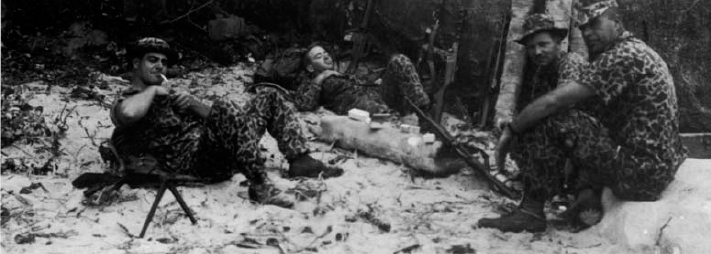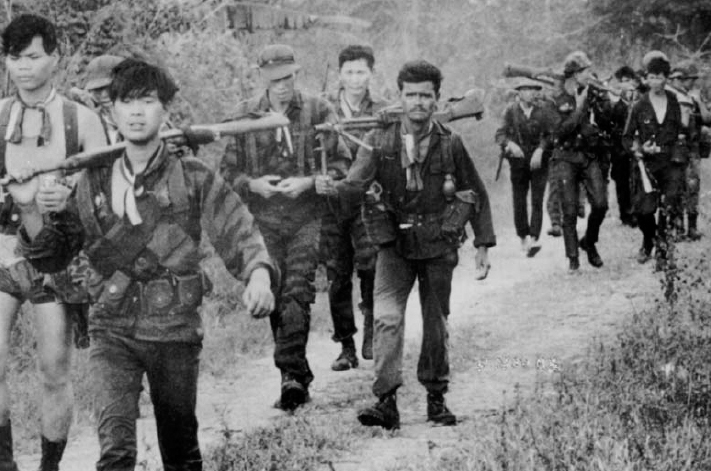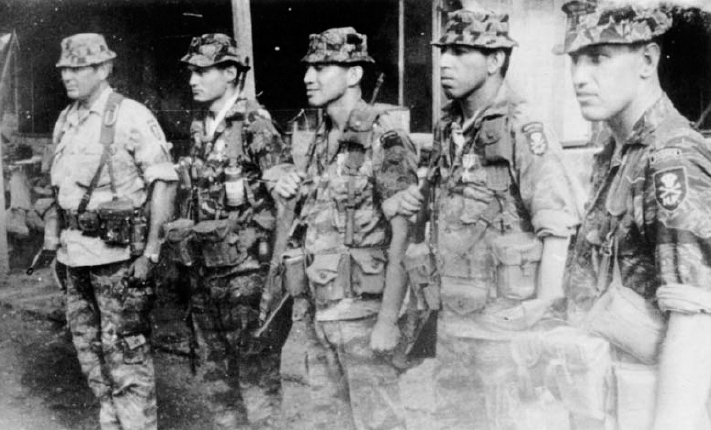
The standards for SF selection have always been high; although they have been raised and lowered as demanded by strength requirements over the years, the overall prerequisites have changed little. These take into account an individual’s background (both civilian and military), mental aptitude, physical ability, and certain military administrative requirements. SF troops are triple volunteers—for the Army, for airborne, and for SF. An individual must complete Basic Training, Advanced Individual Training (where he is trained in his Military Occupation Speciality or MOS), and the three week Airborne Course (where he becomes a qualified parachutist). An individual slated for SF training will usually be trained as an infantryman. Individuals who have been in the service must complete the Airborne Course before attending SF training. Officers must meet the same basic requirements as enlisted men, and must have completed their basic branch training.

Members of Detachment A-222, Dong Tre Strike Force, relax after the discovery of a large arms cache in Phu Yen Province, February 1965. They wear the spotted camouflage uniform. (US Army)
SF training begins at Ft Bragg, where the students are assigned to the Special Forces School to attend the SF Qualification Course, or ‘Q’ Course. The ‘Q’ Course (formerly SF Tactics and Techniques) is divided into three phases. Details, training emphasis, locations, etc. have changed, but the overall content of today’s ‘Q’ Course is much the same as it was 20 years ago. Attrition is high, although not as high as it was in the early days.
The goal of Phase I is to teach the common skills required by all SF troops, to test them physically and mentally, and to eliminate those lacking the required motivation and initiative. The skills concentrated upon are land navigation, patrolling, and survival (methods of instruction were taught in Phase I, but are now covered in Phase II). Physical testing is accomplished by distance runs, rucksack marches, and confidence and obstacle courses. This four week phase also includes a couple of parachute jumps, a period of five days without food (while all training continues), tactical patrolling exercises and land navigation courses. The green beret is awarded upon completion of Phase I.

Chinese Nungs of the 3rd Mike Force returning from Operation ‘Golden Gate’, November 1966. They are armed with M2 carbines and M1918A2 BARs. (US Army)
Phase II is where the students learn their SF speciality training committees. Physical training continues at a fast pace. This phase is primarily academic, although ‘hands-on’, performance-oriented training is conducted to the extent possible. Emphasis is also placed on being able to teach these skills to others. Except for the medical course, Phase II is eight weeks long.
The engineer course covers conventional and unconventional (home made) explosives; demolitions techniques; obstacle, light building and bridge construction; and engineer reconnaissance. Some SF engineers are sent to the Army’s Engineer School for additional training such as heavy construction equipment operation.
The weapons course is divided into light and heavy weapons. The light weapons portion trains the student to operate and disassemble dozens of small arms: handguns, rifles, sub-machine guns, machine guns, grenade launchers, etc. Current and obsolete US, Allied, and Communist weapons are studied—the older weapons especially, as guerrillas will usually be armed with these. The heavy weapons portion deals with mortars, recoilless rifles, and infantry rocket launchers. The mortar training predominates.
The communications course was at one time 16 weeks long. It is shorter now due to the simplicity of the newer radios, their ease of repair, and less time being spent on radio theory. Operation of SF radios and burst message devices, cryptographic systems, manual Morse Code, and the many clandestine SF communications techniques are covered.
The 25 week medical course is the most difficult one, although at one time it lasted 39 weeks. It is divided into 13 weeks at the Army’s Academy of Health Sciences at Ft Sam Houston, Texas followed by six weeks of on-the-job training at an Army hospital, and then six weeks of patient care and lab techniques. Regardless of the course’s length the SF medic is extensively trained in advanced field medical procedures, and is highly respected by his fellow team members.

The commander (right) and some NCOs of Detachment A-302 of the 3rd Mike Force, after receiving Silver Stars for their part in Operation ‘Attleboro’, December 1966. (P. Lopez)
The operations and intelligence course is for senior NCOs and covers the many aspects of mission planning, and UW and special operations intelligence techniques. It is not conducted during Phase II, but taken by team operations sergeants.
Phase III is where the students can put into practice all that they have learned at the team level. During this phase’s four weeks they learn the basics of UW operations and mission planning. It is completed by a two week UW exercise. Students plan and otherwise prepare for the mission, and then parachute into Uwharrie National Forest north of Ft Bragg. Each team links up with its guerrilla group (made up of instructor-led SF students). The student team will organise and train the guerrillas and then assist them in the execution of a raid plus other UW tasks. The students graduate upon accomplishing Phase III, and are now ‘flash qualified’.
Officers were initially trained in a manner similar to enlisted men with much of the training being accomplished within the units. In 1956 the SF Officer Course was established; this was always a 12 week course. It covered many of the same areas as the enlisted Phases I and III with the addition of the many planning, operational, and intelligence aspects of UW and special operations. Since 1981, however, the officers have been integrated with the enlisted men, conducting Phases I and III with them and undertaking their own Phase II training.
Once assigned to an SF unit the trooper has ample opportunities for additional training—in fact his training never really ends. Even in Vietnam, from the late 1960s, SF troops went through a two week Combat Orientation Course conducted by the Recondo School. Additional individual and team training are conducted continuously. This includes MOS cross-training and language qualification (not every man is trained in a second language, contrary to popular opinion). Advanced training in SCUBA and free-fall parachuting are also conducted by selected individuals. Other Army courses are also available such as the Ranger; Pathfinder; Jumpmaster; and Survival, Evasion, Resistance and Escape Courses. Unit training encompasses exercises in different terrain and weather environments.